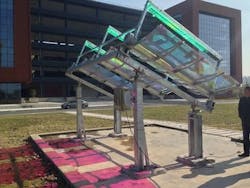New solar panels harvest energy and also allow crops to grow underneath
In countries where farmland is limited, solar panel insulation is not a realistic option, says Jan Ingenhoff, a research professor at the Institute of Advanced Technology (IAT), the University of Science & Technology of China (USTC).
RELATED ARTICLE: Adding luminescent solar concentrators atop greenhouses doesn’t hurt plant growth (and sometimes helps)
"If you look at the solar panels that are typically installed on farmland areas, you can't do much beneath them so farmers have basically had to give up part of their land for this solar panel insulation," Ingenhoff, in an interview with R&D Magazine, said. "Some farmers are OK with it because they have very large land areas, but in countries like Israel or China, where you have a shortage of land, it is not good to sacrifice that land for regular solar panels."
To solve this problem, Ingenhoff--along with his colleague Wen Liu and their team at USTC--developed the Agriculture Solar Concentrator Photovoltaic, a new type of solar panel system that allows for simultaneous plant growth and solar energy generation on the same land. The team currently has four working prototypes installed in China, a country in urgent need of maintaining and recovering any agricultural land due to drastic urbanization in the past.
The researchers have two more installations planned for 2019 and 2020, and are moving toward making their system commercially available through creation of a startup called Fuyang Angkefeng (China) Optoelectronic Technology, which Liu is the chairman of.
The technology was a 2017 R&D 100 Award winner. It is based on the concept that plants don’t actually need 100% of the light sources the sun provides, Ingenhoff explained. "Plants need only about 10 percent of the light, some blue and some red light and that's all. The rest you can leverage for solar energy generation," he said. "The solar panels could be described as semi-transparent."
The system uses curved solar panels that are covered with a film created by several polymer layers staged together to form a dichroitic multilayer film. This allows the selective transmission of only the wavelengths necessary for photosynthesis and plant growth. All remaining sunlight is reflected and focused to concentrating solar cells for photovoltaic power generation. A dual tracking system ensures that the reflected wavelengths are focused on the concentrating solar cells throughout the day.
The way the light is split between solar energy generation and the plants can also be adjusted for specific plant needs, Ingenhoff said. "We have studied what kind of light different plants need," he said. "For example tomatoes need a little bit more red light, while lettuce may need a little bit more blue light. You can adjust this very specifically to these plants and what they need."
Currently, the system can produce approximately 90 W per square meter of energy, but the researchers are working to optimize their film to transmit more precisely the amount of light the plants need to increase its energy generation to 120 to 130 W per square meter. This is slightly short of the 150 W per square meter of energy that conventional solar panels produce, Ingenhoff said.
In addition to solar energy generation, the Agriculture Solar Concentrator Photovoltaic can also be used to improve plant growth, especially in drought-stricken regions. One of the reasons for this is that if you block these near infrared (NIR) and far infrared (FIR) light from reaching the plants, you protect them from the heat, and the water evaporation on the farm is reduced.
The researchers grew lettuce, cucumber and water spinach with the film covering and without the film and found that the lettuce grew to 17.59 cm with the film and 12.83 cm without, the cucumber grew to 15.50 cm with film and 15 cm without, and the water spinach grew to 12.67 cm with film, and 11.160 cm without.
The team is currently working to expand the use of their system outside of Asia and is working with potential clients in Spain as well as the National Renewable Energy Laboratory (NREL) in Colorado to set up joint activities and new prototypes.
SOURCE: R&D Magazine/Laura Panjwani; https://www.rdmag.com/article/2018/06/solar-panel-innovation-allows-plant-growth-energy-generation-simultaneously
About the Author

Gail Overton
Senior Editor (2004-2020)
Gail has more than 30 years of engineering, marketing, product management, and editorial experience in the photonics and optical communications industry. Before joining the staff at Laser Focus World in 2004, she held many product management and product marketing roles in the fiber-optics industry, most notably at Hughes (El Segundo, CA), GTE Labs (Waltham, MA), Corning (Corning, NY), Photon Kinetics (Beaverton, OR), and Newport Corporation (Irvine, CA). During her marketing career, Gail published articles in WDM Solutions and Sensors magazine and traveled internationally to conduct product and sales training. Gail received her BS degree in physics, with an emphasis in optics, from San Diego State University in San Diego, CA in May 1986.
